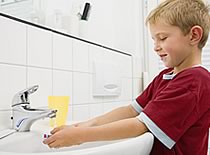Steps to Lessen the Spread of Flu in the Home
When providing care to a household member who is sick with influenza, the most important ways to protect yourself and others who are not sick are to:
 keep the sick person away from other people as much as possible (see “placement of the sick person”) especially others who are at high risk for complications from influenza
keep the sick person away from other people as much as possible (see “placement of the sick person”) especially others who are at high risk for complications from influenza- remind the sick person to cover their coughs, and clean their hands with soap and water or an alcohol-based hand rub often, especially after coughing and/or sneezing
- have everyone in the household clean their hands often, using soap and water or an alcohol-based hand rub. Children may need reminders or help keeping their hands clean
- ask your health care provider if household contacts of the sick person—particularly those contacts who may be pregnant or have chronic health conditions—should take antiviral medications such as oseltamivir (Tamiflu®) or zanamivir (Relenza®) to prevent the flu
- If you are in a high risk group for complications from influenza, you should attempt to avoid close contact (within 6 feet) with household members who are sick with influenza. If close contact with a sick individual is unavoidable, consider wearing a facemask or respirator, if available and tolerable. Infants should not be cared for by sick family members. For more information, see the Interim Recommendations for Facemask and Respirator Use
Placement of the sick person
- Keep the sick person in a room separate from the common areas of the house. (For example, a spare bedroom with its own bathroom, if that’s possible.) Keep the sickroom door closed.
- Unless necessary for medical care or other necessities, people who are sick with an influenza-like-illness should stay home and minimize contact with others, including avoiding travel, for 7 days after their symptoms begin or until they have been symptom-free for 24 hours, whichever is longer. Children, especially younger children, might potentially be contagious for longer periods.
- If persons with the flu need to leave the home (for example, for medical care), they should wear a facemask, if available and tolerable, and cover their nose and mouth when coughing or sneezing
- Have the sick person wear a facemask – if available and tolerable – if they need to be in a common area of the house near other persons.
- If possible, sick persons should use a separate bathroom. This bathroom should be cleaned daily with household disinfectant.

0 comments:
Post a Comment